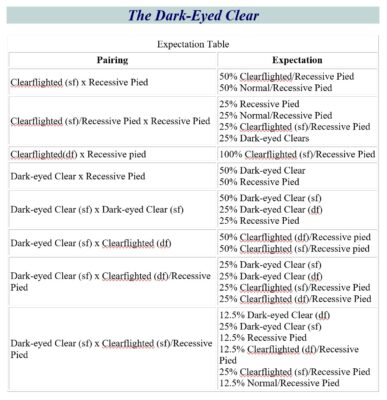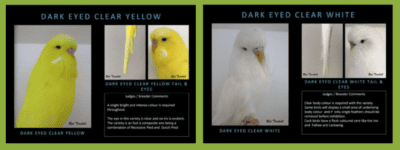
The Dark Eyed Clear Budgerigar
The budgerigars known as Dark-Eyed Clears are characterised by their clear yellow or white plumage devoid of markings or color pigmentation, covering their entire body and wings. While similar to Lutinos and Albinos in appearance, Dark Eyed Clears have solid black eyes without the white iris ring and are sometimes referred to as “Black-Eyed Clears.” What’s more, they share a common feature with Recessive Pieds in having a black eye, but unlike Pieds, they lack any markings.
A dark eyed clear can mask any color and may appear as a different color than their genetic makeup suggests. For example, a visually yellow dark eyed clear may actually be an olive green or a light green, with the shade of yellow varying depending on the color they mask.
History of the Dark Eyed Clear
Records suggest that dark eyed clear first appeared in Belgium around 1948 and later in Denmark. There is not a well-documented origin for these colors. However, there was widespread confusion amongst breeders about the genetic makeup of this variety. Breeders bred them by crossing colony breeding Dutch Dominant Pieds and Danish Recessive Pieds together. It was unclear why two different types of Pieds, one dominant and one recessive, would produce a bird free from any color pigmentation. Eventually, it was understood that dark eyed clear budgerigars were a synthetic color resulting from the mixing of two different forms of Pieds.
By the 1950s, DEC had gained popularity, and breeders found that pairing a Continental Clearflight with a Recessive Pied produced half Clearflight’s and half Normals, all split for Recessive Pied, with a certain percentage of the young being dark eyed clears.
Understanding DEC: One of the Five Recognized Self Coloured Varieties
DECs are one of the five recognized self-coloured bird varieties, and they hold a distinct place among bird breeders and enthusiasts. These five varieties include:
- Blackeyed Selfs: With faint markings on the back of the neck and wings, dark eyes, and an iris ring.
- Inos (Lutinos and Albinos): These have no markings, red eyes, and an iris ring.
- Lacewings: Composites of Ino and Cinnamonwing with distinctive wing markings, red eyes, and an iris ring.
- Spangle Double Factors: These have no markings, black eyes, and an iris ring.
- DECs: Differing by not having an iris ring, they have no markings and dark eyes.
The DEC variety can either be yellow (green series) or white (blue series).
Characteristics of Self-Coloured Varieties
The five self-coloured varieties differ in various ways. Notably, DECs have no markings, dark eyes, and are unique for not having an iris ring. They share features like the absence of an iris ring and the flesh-coloured cere in DEC cocks with Recessive Pieds.
Dark Eyed Clear’s & the Pied Group
Upon analyzing the genetic composition, we find that DECs are part of the Pied Group, which also includes the Dominant Pied, Recessive Pied, Dutch Dominant Pied, and the composite known as the DEC. The DEC stands out for its complete absence of melanin, leaving behind its ground colour.
Genetic Explanation of the Dark Eyed Clear Budgerigar
Dark eyed clears carry one dominant gene for Clearflight and two recessive genes for Recessive Pied. Given that, any given pairing will produce different varieties depending on the partner. When paired with a Recessive Pied, the recessive genes will act, theoretically resulting in equal numbers of dark eyed clears and Recessive Pieds. However, pairing a dark eyed clear with a normal will produce Clearflights and Normals, all split for Recessive Pied. In this case, the dominant Clearflight gene will act, and the recessive genes of the dark eyed clear will continue to be present in the progeny in a hidden form. Thus, the resulting progeny are all split for Recessive Pied.
Pairing a Clearflight split Recessive Pied with a dark-eyed clear will activate both dominant genes on both sides, producing dark-eyed clears, Clearflights, and Normals. The recessive genes of the dark-eyed clear make the Normals split Recessive Pied. The recessive gene on both sides will also result in the appearance of Recessive Pieds.
The dark eyed clear’s dominant and recessive genes act differently depending on the partner, with the presence of a dominant gene in the dark eyed clear makeup allowing it to be present in a single or double dosage. To that end, a single or double factor form is visually indistinguishable from each other.

Image Courtesy of Rod Turnbull and the ANBC
Identification of the Dark Eyed Clear Budgerigar
The ANBC formally entered the dark-eyed clear onto the Show matrix in 2016. The Standard of Excellence requires the bird have body colour, rump and underparts that are solid, and uniform throughout. Dark-eyed Clears are completely clear yellow or white with no trace of the feint markings often seen in Inos. The eye is a solid jet black or deep plum with no visible iris ring, like Recessive Pieds. The cheek patches are silvery white, and the beak, cere and feet are also like those of the Recessive Pied. The mask is to be clear, deep and wide (not cleft), extending beyond two large cheek patches.
The cock has a blue cere whilst the hen has a brown cere. They resemble Inos and double factor spangles except for the eye. To that end, inos have a red eye with a white iris. Meanwhile, Double Factor Spangles have a black eye with a white iris. In comparison, Dark Eyed Clears have a dark or plum eye, but without an iris ring.

Suggested Pairings to Produce Dark Eyed Clear Budgerigars
Dark Eyed Clears are unlike any other variety. Pairing a Recessive Pied with a Dutch Dominant Pied masking a recessive pied gene produces some dark eyed clears.

Click here to view The Dark-Eyed Clear Budgerigar in full.

The distinct characteristics and breeding methods of DECs make them an intriguing aspect of avian genetics and bird breeding. Whether a professional breeder or an enthusiast, understanding the properties and heritage of DECs can provide insights into bird varieties and breeding strategies. The debate over the necessity of DECs as another self-coloured variety adds to their intrigue and highlights the complexities of avian genetics.
